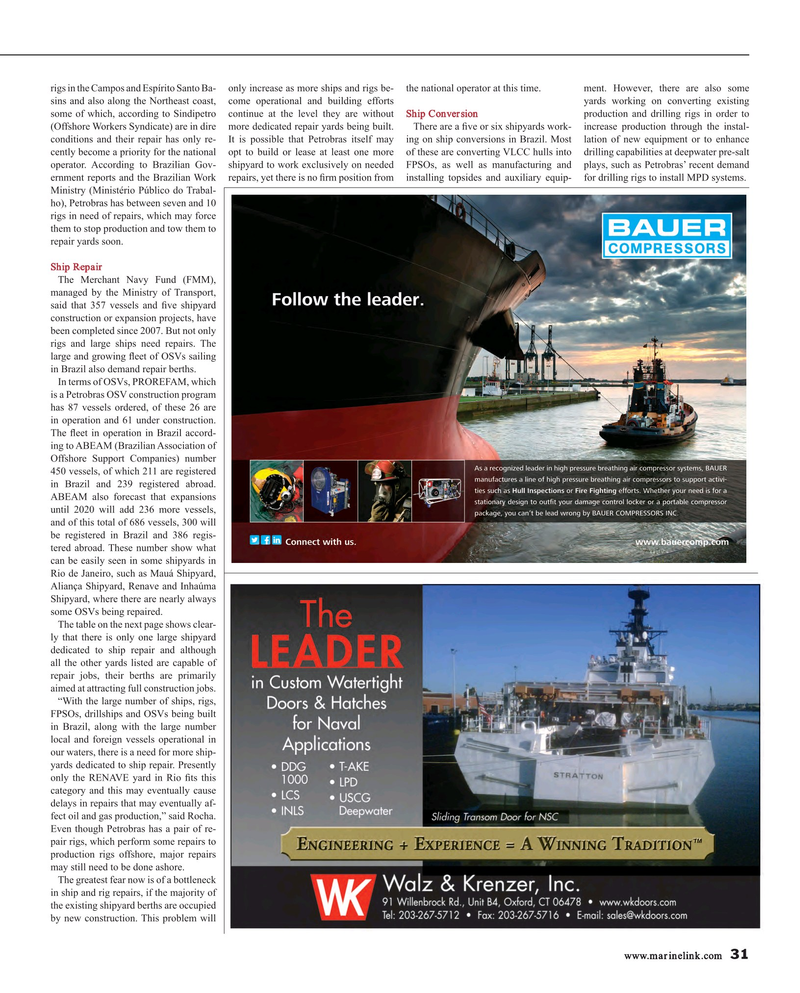
Page 31: of Maritime Reporter Magazine (January 2015)
Ship Repair & Conversion Edition
Read this page in Pdf, Flash or Html5 edition of January 2015 Maritime Reporter Magazine
rigs in the Campos and Espírito Santo Ba- only increase as more ships and rigs be- the national operator at this time. ment. However, there are also some sins and also along the Northeast coast, come operational and building efforts yards working on converting existing some of which, according to Sindipetro continue at the level they are without Ship Conversion production and drilling rigs in order to (Offshore Workers Syndicate) are in dire more dedicated repair yards being built. There are a ? ve or six shipyards work- increase production through the instal- conditions and their repair has only re- It is possible that Petrobras itself may ing on ship conversions in Brazil. Most lation of new equipment or to enhance cently become a priority for the national opt to build or lease at least one more of these are converting VLCC hulls into drilling capabilities at deepwater pre-salt operator. According to Brazilian Gov- shipyard to work exclusively on needed FPSOs, as well as manufacturing and plays, such as Petrobras’ recent demand ernment reports and the Brazilian Work repairs, yet there is no ? rm position from installing topsides and auxiliary equip- for drilling rigs to install MPD systems.
Ministry (Ministério Público do Trabal- ho), Petrobras has between seven and 10 rigs in need of repairs, which may force them to stop production and tow them to repair yards soon.
Ship Repair
The Merchant Navy Fund (FMM), managed by the Ministry of Transport, said that 357 vessels and ? ve shipyard construction or expansion projects, have been completed since 2007. But not only rigs and large ships need repairs. The large and growing ? eet of OSVs sailing in Brazil also demand repair berths.
In terms of OSVs, PROREFAM, which is a Petrobras OSV construction program has 87 vessels ordered, of these 26 are in operation and 61 under construction.
The ? eet in operation in Brazil accord- ing to ABEAM (Brazilian Association of
Offshore Support Companies) number 450 vessels, of which 211 are registered in Brazil and 239 registered abroad.
ABEAM also forecast that expansions until 2020 will add 236 more vessels, and of this total of 686 vessels, 300 will be registered in Brazil and 386 regis- tered abroad. These number show what can be easily seen in some shipyards in
Rio de Janeiro, such as Mauá Shipyard,
Aliança Shipyard, Renave and Inhaúma
Shipyard, where there are nearly always some OSVs being repaired.
The table on the next page shows clear- ly that there is only one large shipyard dedicated to ship repair and although all the other yards listed are capable of repair jobs, their berths are primarily aimed at attracting full construction jobs. “With the large number of ships, rigs,
FPSOs, drillships and OSVs being built in Brazil, along with the large number local and foreign vessels operational in our waters, there is a need for more ship- yards dedicated to ship repair. Presently only the RENAVE yard in Rio ? ts this category and this may eventually cause delays in repairs that may eventually af- fect oil and gas production,” said Rocha.
Even though Petrobras has a pair of re- pair rigs, which perform some repairs to production rigs offshore, major repairs may still need to be done ashore.
The greatest fear now is of a bottleneck in ship and rig repairs, if the majority of the existing shipyard berths are occupied by new construction. This problem will www.marinelink.com 31
MR #1 (26-33).indd 31 MR #1 (26-33).indd 31 1/8/2015 9:08:52 AM1/8/2015 9:08:52 AM

 30
30

 32
32
